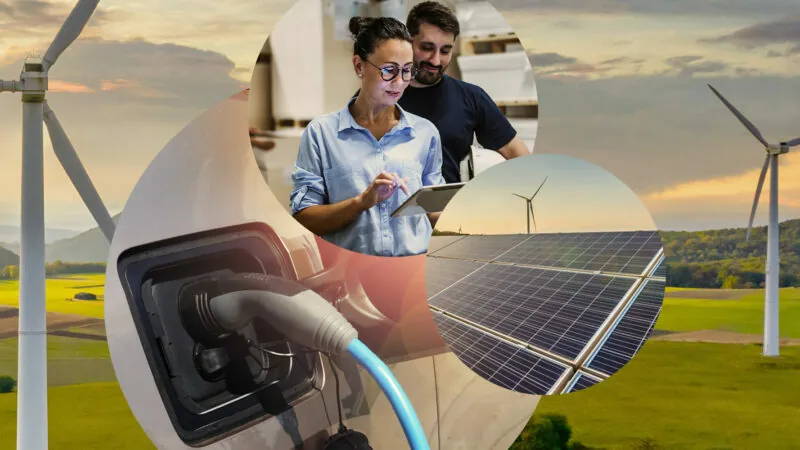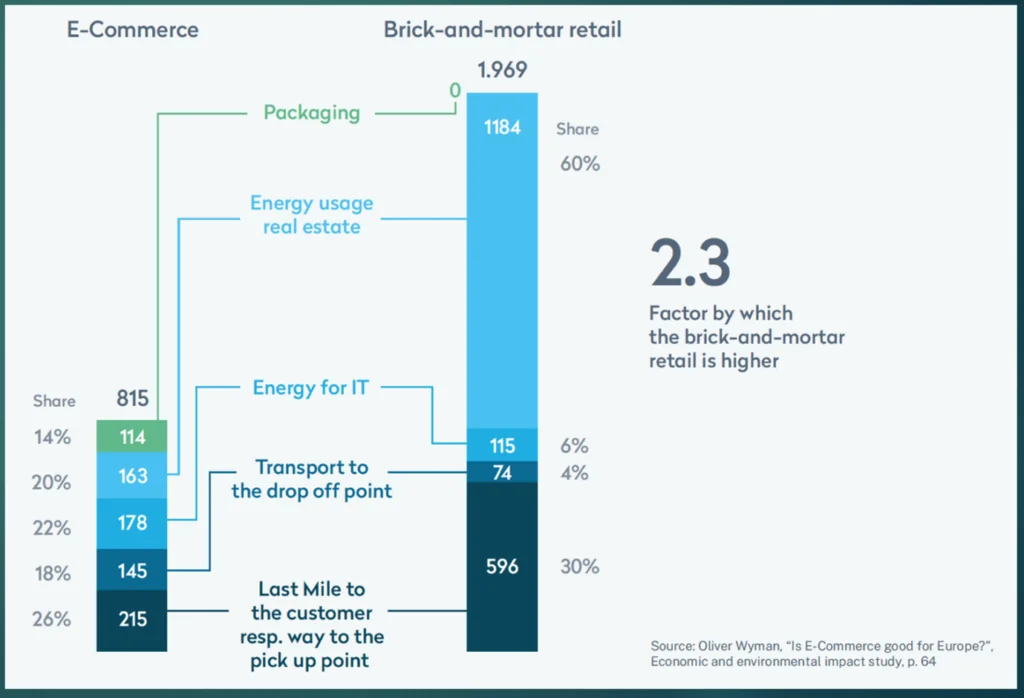Sustainability in e-commerce: where to start and why now?
October 23, 2023

October 23, 2023

⏰ Estimated reading time: 9 minutes
By: Julia van Meel (Teamlead Marketing, valantic NL) – interview with Dr. Hongli Joosten-Ma (Lector Purposeful Marketing, The Hague University of Applied Sciences) & Jelmer Spoelstra (Managing Director, valantic NL).
Sustainability costs money, it’s a hassle and as an e-commerce company you can go a long way with CO2 compensation. But is that so? What’s really going on? Captivated by the subject, we are stuck in eco-merce in 2023. We spoke with Dr. Hongli Joosten-Ma (lecturer at The Hague University of Applied Sciences) about the latest developments in her field of expertise: purposeful marketing. We will share some of the more than interesting conclusions and figures she drew below. Furthermore, we learned from other sources that we as an industry are doing unexpectedly well in certain areas, but also that we cannot sit back. But first: why? What makes sustainability more than a trend? And why should you, as a company, adjust your strategy accordingly?
The topic of sustainability is alive and well in large parts of society. Employers struggle with the subject, employees seek meaningful work, and clients have higher demands. In addition, governments are coming up with more regulations. All in all, there is a growing awareness around the theme, so sustainability is no longer optional, or something you can do as an e-commerce company, according to Dr. Joosten-Ma. The figures she cites confirm this. Below you can read striking conclusions from the studies she mentions.
More than 75% of CEOs experience that stakeholders are increasing the pressure for the introduction of more or more active policies against climate issues. 80% of companies also invest in the development of sustainable products, or have plans to do so. This tells us that the theme of sustainability has reached the boardrooms.
Consumers also find sustainability increasingly important: in 2021, almost a third of consumers bought from brands that are in line with their personal values. More than a quarter of consumers boycott brands that aren’t. For Millennials and Gen-Z, an eye for social values is even more important, dr. Joosten-Ma’s research team found in an ongoing study among its own students. For example, 95% of the students indicated that their buying behavior is influenced by the behavior of companies behind the products. This is relevant for the industry, because it is precisely the gen-Z and the Millennials that are important target groups for e-commerce.
Sustainability and positive impact are also important for employees. Especially in the current tight labour market, it is unwise to ignore the figures on this. For example, research into marketing trends shows that purpose-driven companies have 40% more employee retention. Among Millennials and Gen-Z, those numbers are even higher, Dr. Joosten-Ma’s research team found. Also, 30% of the research group indicate that they would probably accept a 10% lower salary if their employer deals with socially relevant themes. These are serious figures that are endorsed time and time again.
Sustainability is therefore not something you should ignore or underestimate. E-commerce also has industry-specific challenges. Consider, for example, concerns from society about shipping (polluting vans with packages) and the amount of packaging. Now the environmental impact of our industry compared to retail is not so bad – more on that later – but we have to do something with our bad name. In addition, there are certainly considerable improvements that can be made. Plus: if you as an e-commerce company prioritize sustainability on both a strategic and practical level, this can provide a significant competitive advantage. It can also protect your brand and ensure more growth and greater employee satisfaction.
You may have noticed that we use a lot of terms interchangeably: sustainability, positive impact, sustainable, purpose-driven, etc. In addition, not every term can be translated equally well or completely into Dutch. Whereas when we think of ‘sustainable’ we generally think mainly of ‘green’ and environmentally friendly, the concept of ‘sustainable‘ is certainly broader than that in the context of this article: it refers to the Sustainability Goals of the United Nations. Many of these 17 goals are directly or indirectly about the environment, but there are also goals that deal with gender equality, inclusivity and education. At valantic we mainly talk about sustainability and positive impact in this broad sense of the word.
We have a reputation for being a polluting industry, with smelly vans in the streets, lots of returns that end up in rubbish heaps in the poorest developing countries and unnecessary amounts of packaging material. Of course, there is still a lot to improve and we will certainly come back to that later. But when you compare the numbers of retail with the numbers of e-commerce, we’re actually doing pretty well. In other words: all in all, the footprint of a webshop is smaller than that of a physical store. This is mainly because a building consumes an enormous amount of energy (see figure 1).

The fact that we are doing better overall than our ‘neighbour’ the retailer does not mean that it is good enough and that we can sit still. After all, there are still vans that drive for nothing, unnecessary returns, useless packaging and consumers who – in our view: rightly – have concerns about this. The aforementioned figures also show that these are consumers who are willing to switch to the competitor when they do pay attention to sustainability. There are more and more, because as you could read at the beginning of this article, the theme has reached the vast majority of boardrooms. So we have to do something, but isn’t that very expensive?
As consumers and also as an industry, we have often grown up with the idea that sustainability costs money. This way we can compensate our flight with a simple tick if we want to pay a few euros extra. Or can we opt for organic food when we spend more on our groceries. Because of this, you might think that sustainable equals expensive. But you don’t have to. It turns out that companies can increase their operating profit by up to 60% through more efficient processes and more sensible use of raw materials. In this way, what is good for the environment is also good for the wallet.
We heard an example of this during the Websummit in Lisbon in 2022, where Siemens talked about the construction of their new factory. From a sustainability point of view, they first tested them for a year with 3D models. In addition to obvious things like solar panels, they also focused on the processes, such as the most efficient walking lines of the robots. During the final construction, the climate impact of this optimized factory was 60% lower than that of a classic factory. In addition, the construction of the factory also cost 40% less than budgeted. In other words: a smaller impact on the climate and a significant cost reduction. Win – win.
Sustainability goals can therefore go hand in hand with increasing profits. In the example above it is something big, but even in small changes there is profit to be made, certainly also within e-commerce. You can read examples of this below.
In addition to direct profit or reduced costs, Sustainability can also indirectly add value to your brand. Sustainability can be a powerful marketing tool, especially within e-commerce. Provided you mean it. Consumers smell greenwashing from miles away. This damages trust and it is difficult to recoup that. Authenticity is the most important keyword here. Incorporate sustainability into your business strategy and make it more and more a part of all your business processes. Not with it, next to it or occasionally, but integrated. That may take time and not everything has to be perfect right away, as long as customers see that you are taking steps and that you mean it.
Then feel free to share the steps you are taking as a company in the field of sustainability with the rest of the world. Modesty is not necessary; This unnecessarily misses a marketing opportunity. It is important that you remain transparent in communication with customers and relations. Don’t blame successes and don’t hide where things can really be improved. Certainly the new generation of consumers (Gen-Z) is critical in this area and is more likely to do a fact check when you as a company claim something.
So make sure you have reliable sources and be honest about what you do and don’t do (yet). A good example of this is Tony Chocolony. The brand is very strong in the field of purposeful marketing: they convey what they do well, but also indicate when something is not yet going well in the chain and what they want to do about it.
What we now regularly see is that sustainability does have a place in the long-term plans, but that the subject regularly does not or hardly appears in the annual plans. The will is there, because companies see how important the theme is for their customers, relations, governments and employees. At the same time, many companies do not know how to make the transition from purely profit-oriented to a more sustainable e-commerce company. It starts with the fact that, for example, there are KPIs in the field of growth and turnover, but not (yet) in the field of sustainability. This keeps the subject secondary and something will remain ‘for the side’.
Dr. Joosten-Ma recognizes and endorses this. Her advice to these companies is to look at the company with a more holistic view. In addition to the goals you have in the field of growth, for example, also choose goals that promote responsible consumption. A tool that companies can use for this is the ‘Purpose-driven Maturity Matrix’, developed by her professorship at The Hague University of Applied Sciences. If you are interested in the matrix, please contact the Purposeful Marketing Research Group.
Of course, we don’t all have to invent the wheel ourselves, so what can you practically do as an e-commerce company in the field of sustainability?
1. Reducing and making packaging material more sustainable
By using less and more environmentally friendly packaging, you as a company reduce the amount of waste. Two of our customers worked together to achieve this: packaging supplier Paardekooper and men’s clothing brand State of Art jointly developed a flatter box of a more environmentally friendly cardboard type with minimal printing. They did not compromise on the look and feel of the packaging. Because the box is now smaller than before, it takes up less space, resulting in lower CO2 emissions during transport per package. Fewer raw materials are also needed and the new boxes are more recyclable.
2. Reduce CO2 emissions during transport and delivery
We already mentioned it above: by smaller packaging you reduce CO2 emissions during transport per package. A well-known example of this is Ikea, which has been working according to this principle for decades. Ikea goes even further and takes this into account already in the design phase of the products themselves. In addition, you can invest in sustainable shipping methods for the delivery of products, such as the use of electric vehicles or bicycles. Think, for example, of the small, electric trucks from online supermarket Picnic. More and more companies are also informing their customers about the most sustainable delivery times, allowing customers to choose a more environmentally friendly option.
3. Energy efficiency
As you could see in figure 1, as an e-commerce industry we (logically) have a larger ecological footprint in terms of IT use than traditional stores. Of course, we need computer equipment and servers, but we can opt for more energy-efficient options. Data centers are also increasingly looking for more environmentally friendly solutions, for example in the field of cooling. Even if you outsource this service and do not have a server yourself, you can make more sustainable choices as an e-commerce company.
4. Reducing returns
Returns are a problem and certainly in the fashion industry. You can partly prevent this by giving consumers a good idea of the products you sell. There is more and more AI software that supports this, such as a virtual fitting room. This allows the consumer to see in advance how the clothing looks on his or her own body. Reviews can also help with this: customers can show other customers how purchased products look and can give feedback about, among other things, size and fit. Others can then use this information to make a better estimate of a product, resulting in fewer mispurchases and therefore fewer returns.
5. Cooperation with sustainable suppliers and relations
Of course, every company can pay attention to sustainability on its own island, but when you work together with others who have the same goals, you increase this impact even more. Choose your partners and suppliers with care and talk to other companies about corporate social responsibility. Make contact and see where you can strengthen and inspire each other.

The sustainability goals live at valantic. That was before we decided a few years ago to include the subject in our core values. In the previous years, as colleagues, we increasingly took the values in this area to the office and talked about it with each other at the coffee machine. In short: it was already a topic that lives from our midst. Sustainability within e-commerce has been one of our most important priorities for a number of years now, but we want more.
We want to continue to take steps and increase our impact, among other things by collaborating with others with the same values. As described above in point 5. So feel free to come and have a cup of coffee. Sometimes it will be just a – hopefully inspiring – conversation, but who knows what else will come out of it.
Do you also want to exchange ideas about sustainability? Please contact us, we like that! Yes, even if you are 😉 a competitor
Don't miss a thing.
Subscribe to our latest blog articles.